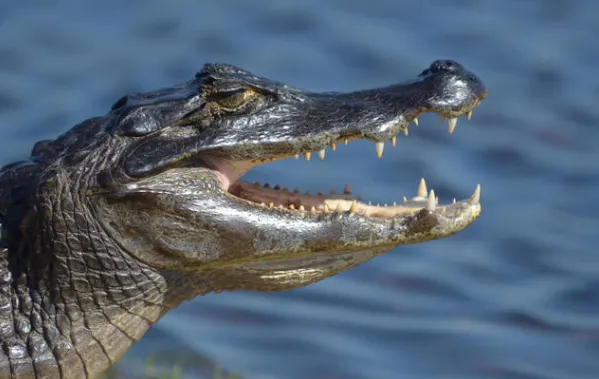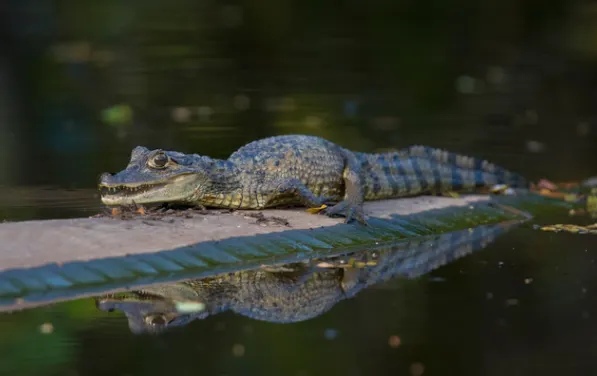Caimans are fascinating semi-aquatic reptiles found in the wetlands of Central and South America. These crocodilian creatures, related to both alligators and crocodiles, play a crucial role as top predators in their ecosystems. With powerful bodies, sharp teeth, and remarkable hunting abilities, caimans have adapted to thrive in their watery habitats. In this blog post, we’ll delve into the classification, evolution, anatomy, distribution, behavior, reproduction, diet, and threats faced by these remarkable reptiles.

Table of Contents
Classification and Evolution: Ancient Reptilian Relics
Caimans belong to the family Alligatoridae, making them close relatives of alligators. There are six recognized species of caiman: the spectacled caiman (Caiman crocodilus), the black caiman (Melanosuchus niger), the yacare caiman (Caiman yacare), the Cuvier’s dwarf caiman (Paleosuchus palpebrosus), the smooth-fronted caiman (Paleosuchus trigonatus), and the broad-snouted caiman (Caiman latirostris). These species inhabit various wetland environments throughout Central and South America.
Caimans are part of the larger group known as crocodilians, which also includes crocodiles, alligators, and gharials. Interestingly, caimans have evolved very little over the past 200 million years, making them some of the longest-surviving species on the planet. They belong to a group of reptiles called archosaurs, which also included dinosaurs. Despite the extinction of dinosaurs 65 million years ago, caimans, along with other crocodilians, continue to thrive.
Anatomy and Appearance: Built for the Hunt
Caimans possess wide, slightly flattened bodies and long, muscular tails that allow them to move through water with incredible power. Their nostrils and eyes are located on the top of their snout and head, enabling them to breathe and see while being almost fully submerged in water. This adaptation allows caimans to remain hidden from potential prey and predators alike.
Caimans have strong jaws lined with cone-shaped teeth that are ideal for catching and consuming prey. When a caiman snaps its jaws shut, the teeth drive into the prey with precision. Caimans cannot chew their
The size of caimans varies by species. The largest species, the black caiman, can grow up to 6 meters (19.7 feet) long, while smaller species, such as the Cuvier’s dwarf caiman, reach about 1.5 meters (4.9 feet) in length. Caimans also vary in color, ranging from dark gray to black in black caimans, to dull olive, gray, or brown in other species. Their skin is covered in plate-like scales, providing protection and aiding in camouflage.
Distribution and Habitat: Masters of the Wetlands
Caimans are found in a wide range of wetland habitats across Central and South America. The spectacled caiman, also known as the common caiman, is the most widespread species and has even been introduced to areas outside its natural range, including Puerto Rico and Cuba. These reptiles inhabit rivers, lakes, and swamplands, with specific habitat preferences varying by species.
The spectacled caiman prefers still waters, such as those found in lakes and swamps, while the black caiman, being larger and more powerful, can withstand stronger currents in rivers. This difference in habitat preference helps reduce competition between species in areas where their ranges overlap. Caimans are also known to inhabit man-made waterways, such as canals and reservoirs, especially when natural habitats are altered by human activity.
Behavior and Lifestyle: Nocturnal Hunters
Caimans are primarily nocturnal, spending most of their daytime hours resting in the water or basking on riverbanks. Although they are semi-aquatic, some species spend more time on land than others. For example, the spectacled caiman rarely leaves the water, while the black caiman often ventures onto land at night to hunt larger prey.
Male caimans are highly territorial and establish dominant hierarchies within their habitats. Dominant males gain access to more desirable territories and mate with more females. During periods of drought, spectacled caimans may burrow into the mud to enter a dormant state, avoiding extreme dryness.
Reproduction and Life Cycles: Caring Mothers
Caimans reach sexual maturity between the ages of four and ten years, depending on the species. The timing of the breeding season also varies by species. For example, spectacled caimans breed during the wet season in May and June, while black caimans breed during the dry season.
Females build nest mounds made of vegetation or mud, which can be as tall as 1.5 meters (4.9 feet). They lay between 30 and 65 eggs in a conical hole at the top of the mound, and the eggs hatch after approximately three months. Female caimans guard their nests during this time, with spectacled caiman females sometimes laying eggs in the same nest and guarding it together.
When the hatchlings call out, the mother caimans help them reach the water by carrying them in their mouths. Female caimans remain with their young for up to a year, protecting them from predators. Juvenile caimans live in large groups called creches and are lighter in color than adults. These markings fade as the caimans age.
Diet and Prey: Apex Predators of the Waterways
Caimans are formidable carnivores, hunting a wide variety of prey. Their diet primarily consists of aquatic animals, such as fish (including catfish and piranhas), crustaceans, and amphibians. They also hunt birds, particularly waterfowl, and small mammals. Larger caimans, such as the black caiman, have been known to prey on capybaras, wild pigs, and even humans.
Caimans use different hunting techniques depending on their prey. They often remain close to riverbanks, lying in wait for mammals to come to the water to drink or cross to the other side. Caimans may also silently drift through the water with only their eyes and nostrils exposed, hoping to sneak up on unsuspecting prey.
Predators and Threats: Surviving Against the Odds
Adult caimans have few natural predators due to their size and strength. However, large cats such as jaguars are known to prey on caimans. Young caimans, being smaller and more vulnerable, face a greater number of predators, including wild cats, birds of prey, snakes, and omnivorous mammals like wild pigs.
Caimans are also threatened by habitat degradation, primarily due to deforestation and water pollution. Additionally, they have been hunted for their skins, which are used in the production of clothing, and for their meat, which serves as a protein source for local populations.

Conservation Status: Resilient Yet Vulnerable
Despite facing numerous threats, caimans are currently listed as “Least Concern” by the International Union for Conservation of Nature (IUCN). However, some species, such as the black caiman, have experienced significant population declines. The black caiman population, for instance, is estimated to have decreased by 99% over the past 100 years.
Interestingly, the decline of larger crocodilian species in Central and South America has allowed caimans to extend their range in some areas. Conservation efforts are essential to ensure the survival of these remarkable reptiles and to maintain the balance of the ecosystems they inhabit.
Caimans are extraordinary reptiles that have adapted to life in some of the most challenging environments on Earth. As apex predators, they play a vital role in maintaining the health of their ecosystems. However, they also face significant challenges, including habitat loss, hunting, and environmental changes. By understanding more about these incredible creatures, we can appreciate the importance of their conservation and work towards protecting them for future generations.
- Enchi Ball Python: A Unique and Stunning Morph of Python regius - March 27, 2025
- Emerald Tree Monitor: The Enigmatic Green Guardian of the Rainforest - March 26, 2025
- The Egyptian Cobra (Naja haje): A Fascinating Serpent - March 25, 2025
